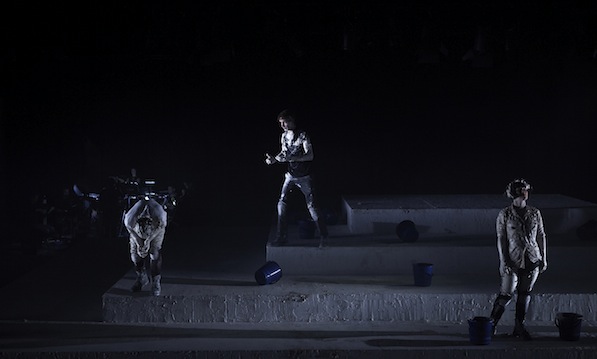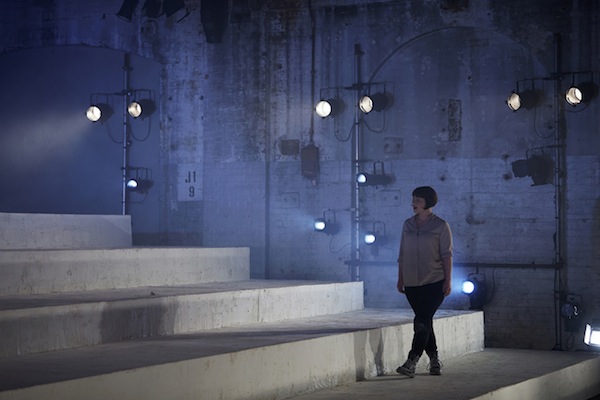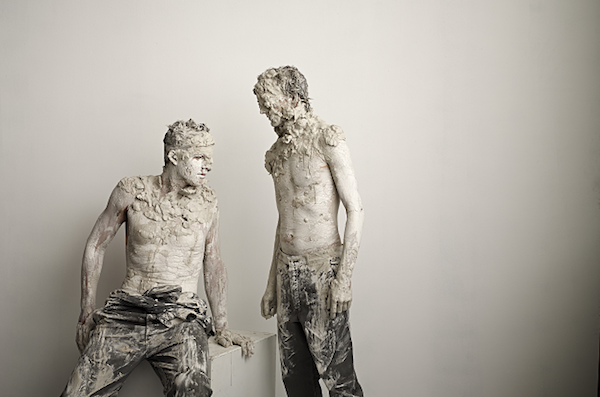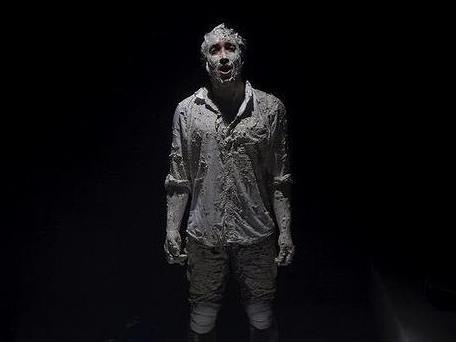Brenton Spiteri stood out in the performance, effortless moving between characters and range in Sydney Chamber Opera’s new work Fly Away Peter. Photo by Toby Burrows
Fly Away Peter is an adaption of Australian writer David Malouf’s 1982 novella of the same title, while the score is a contemporary take on Stravinsky’s 1918 work, A Soldier’s Tale. It’s a hard starting point for any production to stitch together those “narratives of giants” while elevating them to a new signature.
To do so, composer Elliott Gyger and librettist Pierce Wilcox used the abstract element of time, brilliantly lacing elements together in this world premier by Sydney Chamber Opera (SCO).
Most literally, time bridges a narrative between a World War One memory and a stark contemporary consideration of conflict and loss. From a more abstract consideration, time is represented as the symbolic suturing of Australian birdsong to another song of flight witnessed above the trenches – a violin and a voice bouncing off each other in bird call. It plays with familiarity, and yet is hauntingly displaced, hanging in space. It illustrates the layers to this production, which is thoughtfully constructed and in sympathy with Malouf’s original text.
The audience were also subject to this poetic range of time with the single act 70-minute opera a slow space of delivery, the pace ever so slight in its nuances. It drew you into the psyche of the trenches from the start. This was no clichéd version of Gallipoli; nor that of a Queensland landowner.
In all things this opera is spare. Just three performers feature: Mitchell Riley as Jim Sadler, a Queensland birdwatcher who finds himself in the trenches; Brenton Spiteri as Ashley Crowther, landowner and then quotidian army man; and Jessica Aszodi as Imogen Harcourt, a bird photographer, who then becomes an anonymous onlooker over the tragic landscape of war.

Image: Fly Away Peter onstage. Photo: Zan Wimberley
Wilcox did not write an easy opera, choosing fragmentation and repetition of Malouf’s text to build poetic tension. Phrases like ‘See the man’ would be delivered, only to hang in the air then be starkly repeated. It created a tone of melancholy, like a fading memory.
At first the style was hard to get in to, but its persistence without diversion, drew the audience into a particular headspace – one that left you questioning and recollecting after the opera for days afterwards.
Even a non-officiado could recognise that this opera was a really tough sing and, given that the ensemble had its back to the stage and the singers out of eye contact with conductor Jack Symonds, it was an impressive delivery that illustrated the artistic connectivity within this small company.
Baritone Riley suited the role of Jim Sadler, wiry in stature and capturing the slight awkwardness and enthusiasm of youth in his delivery. Tenor Spiteri delivered the strongest vocal performance, effortlessly moving between a range of characters. Mezzo Aszodi, who started off a little over zealous in her diction, managed a difficult role that was very physical while retaining a sweetness of voice.
For composer Gyger this was his first opera. His use of birdsong as a metaphor pierced the score and cleverly drew a line of connectivity through the opera’s length, from a tranquil birdpark to the mechanics of war.
At times it felt like there was disjuncture between the score and libretto, and while unsettling to an unfamiliar ear, it fueled the emotional dislocation and loss that sits core to the narrative of this production. This opera in all aspects uses that notion of duality as its primary foundation.
Fly Away Peter was not just a delivery of a score and libretto; the movement of the ensemble over the set and the physicality of the opera’s delivery were inseparable to its experience.

Mezzo Jessica Aszodi actively used the stepped onstage with dramatic effetc. Photo: Zan Wimberley.
Presented at Carriageworks, the venue’s industrial starkness played superbly into the hands of production designer Elizabeth Gadsby, whose minimal set used a stepped fortress-like structure peppered only with plastic buckets. The company was extremely fluid, visually demarcating place and time often with regimented zeal and others with an exhausted lament for war; It was superbly directed by Imara Savage.
For a visual person, this was the brilliance and great success of this production, that it could stand in for both a Queensland tableland for bird viewing and the spiraled depths of the mud-locked trenches.
Through the performance the singers covered themselves with thick white clay from the buckets, to the point of being swallowed by the horrors of the muddy trenches, appearing somewhat demented or ghostly by the opera’s conclusion. The final placement of the buckets illustrates the dexterity of the prop in Gadsby and Savage’s hands, symbolically lined up as tombstones to those lost. In the closing moments of the opera the names of the men who have died are sung out, sitting on the air with a cold reality.

Fly Away Peter is the latest in SCO’s commissioning program, which has grown a reputation for boldness and pushing the boundaries of the operatic medium in our times. The work underscores the innovative programming and creative talent that is driving a new generation of opera-goers (reflected in the audience), and one that questions the repertoire of the larger more heavily subsidised opera companies.
Keep them on your radar.
Rating: 4.5 out of 5
Sydney Chamber Opera presents the world premiere season of
Fly Away Peter
Music by Elliott Gyger
Libretto by Pierce Wilcox
Conductor: Jack Symonds
Director: Imara Savage
Set & Costume Design: Elizabeth Gadsby
Lighting Design: Verity Hampson
Movement Director: Lucas Jervies
With Mitchell Riley, Jessica Aszodi, Brenton Spiteri
At Sydney’s Carriageworks until 9 May
David Malouf in Conversation at Carriageworks, 9 May at 5pm.





